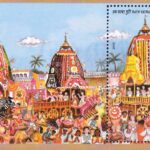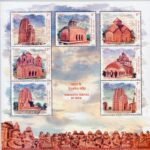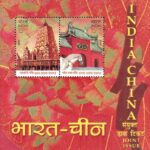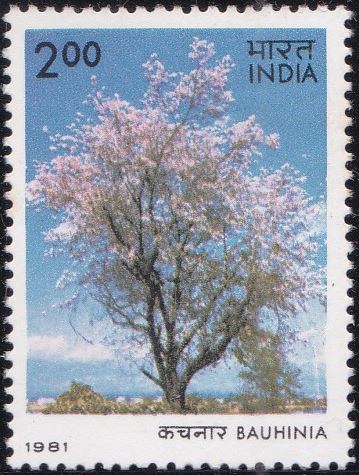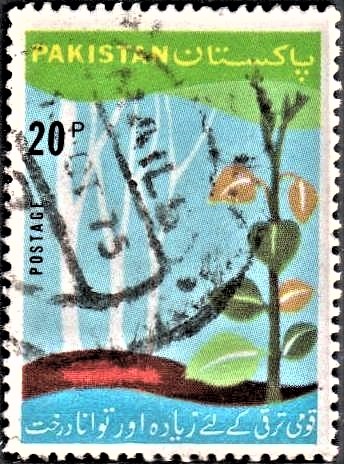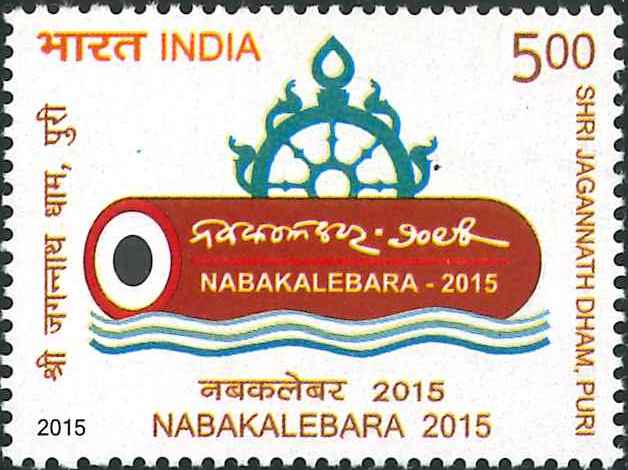
Nabakalebara 2015
A commemorative postage stamp on the Nabakalebara, a symbolic recreation of the wooden forms of four Hindu deities (Jagannath, Balabhadra, Subhadra, and Sudarshana) at Jagannath Temple, Puri :
 Issued by India
Issued by India
Issued on Jul 17, 2015
Issued for : The Department of Posts is happy to release a commemorative postage stamp on the occasion of Nabakalebara 2015.
Credits :
Stamp/FDC/Cancellation : Alka Sharma
Type : Stamp, Mint Condition
Colour : Multi colour
Denomination : 500 Paise
Stamps Printed : 0.6 Million
Printing Process : Wet Offset
Printer : Security Printing Press, Hyderabad
About :
- The term Nabakalebara is an ancient ritual associated with Lord Jagannath Temple of Puri when the Idols of Lord Jagannath, Balabhadra, Subhadra and Sudarshan are replaced by a new set of Idols.
- It is believed that a year which has two months (Adhikamasa) of Ashadha as per the Hindu Calendar is auspicious for conducting the ceremony. This usually occurs every twelve to nineteen years. The Deities are made from a special type of Neem wood known as Daru Brahma. Preparations for the ceremony start in the month of Chaitra. The last such ceremony took place in the year 1996. 2015 is the year when the ceremony will take place next.
- Jirna Bera Parityaga literally means leaving the old deity and consecration of new one. As a person puts on new garments, giving up old ones, the soul similarly accepts new material bodies, giving up the old and useless ones.
- The above philosophical view is applied to Shri Jagannath. According to different secret protocols followed from time immemorial in the temple, provision exists for changing of the deities. As the deities are made up of Neem tree basically, along with Musk, Sandalwood and many other rare combinations, they undergo change of Vigraha before the adhika ashaadha ends.
- No ordinary Neem tree can be used to make the deities. Certain well defined criteria must be satisfied by the tree before it is labelled a Daru Bramha fit for making the deities. Locating the four holy trees requires divine intervention. As per long-standing tradition the Priests of the Jagannath Temple (Puri) worship Maa Mangala at the Kakatpur Mangala Temple. It is said the Goddess appears to them in their dreams revealing the location of the holy trees.
- Puri geared up for Nabakalebara 2015 after the sacred trees were located. The trees are cut down after appropriate ritual observance and the logs are then transported by small carts pulled by devotees all the way to the temple at Puri. Starting at an auspicious hour with the fullest of secrecy the logs are carved into deities within the Temple premises. On the midnight of Adhika Ashadha Krishna Chaturdashi the Tattva Padartha is transferred from the old deities to the new deities. Bramha or tattva padartha is a super natural thing. After this, the new deities are worshipped and the old deities buried in the sand, (Koili Baikuntha) inside the temple premises. Apart from the regulation associated with the selection of tree, there are various rituals associated with locating the same and bringing it to the temple premises.
- Elaborate rituals, numerous myths and several celestial incidents are attached to this auspicious affair. The exact procedure of the transformation of images have been mentioned in the Sanskrit manuscripts written on palm leaves which are kept in the temple. Only the three head priests of the temple have the sole responsibility of reading and interpreting them.
- On the morning of the second day the new deities are seated on the alter, the “Ratna-Singhasana”. On this second day, the daily routine of the temple finally begins again, after a lapse of nearly 58 days. Sweet-smelling flower garlands and new garments are given to the new deities, food is offered, and puja is done. Devotees can again come inside for darshan. And on the third day the new deities emerge from the temple for the biggest Chariot Festival. The Nabakalebara draws millions of people from across the world to Puri, and is one of the biggest festivals in the country.
- Text : Based on the material provided by the proponent.
Subscribe
Login
0 Comments


